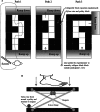Examining links between anxiety, reinvestment and walking when talking by older adults during adaptive gait
- PMID: 26403296
- PMCID: PMC4713710
- DOI: 10.1007/s00221-015-4445-z
Examining links between anxiety, reinvestment and walking when talking by older adults during adaptive gait
Abstract
Falls by older adults often result in reduced quality of life and debilitating fear of further falls. Stopping walking when talking (SWWT) is a significant predictor of future falls by older adults and is thought to reflect age-related increases in attentional demands of walking. We examine whether SWWT is associated with use of explicit movement cues during locomotion, and evaluate if conscious control (i.e. movement specific reinvestment) is causally linked to fall-related anxiety during a complex walking task. We observed whether twenty-four older adults stopped walking when talking when asked a question during an adaptive gait task. After certain trials, participants completed a visuospatial recall task regarding walkway features, or answered questions about their movements during the walk. In a subsequent experimental condition, participants completed the walking task under conditions of raised postural threat. Compared to a control group, participants who SWWT reported higher scores for aspects of reinvestment relating to conscious motor processing but not movement self-consciousness. The higher scores for conscious motor processing were preserved when scores representing cognitive function were included as a covariate. There were no group differences in measures of general cognitive function, visuospatial working memory or balance confidence. However, the SWWT group reported higher scores on a test of external awareness when walking, indicating allocation of attention away from task-relevant environmental features. Under conditions of increased threat, participants self-reported significantly greater state anxiety and reinvestment and displayed more accurate responses about their movements during the task. SWWT is not associated solely with age-related cognitive decline or generic increases in age-related attentional demands of walking. SWWT may be caused by competition for phonological resources of working memory associated with consciously processing motor actions and appears to be causally linked with fall-related anxiety and increased vigilance.
Keywords: Attention; Conscious motor processing; Falls; Fear of falling; Movement self-consciousness; Stops walking when talking; Working memory.
Figures



Similar articles
-
Conscious motor control impairs attentional processing efficiency during precision stepping.Gait Posture. 2018 Jun;63:58-62. doi: 10.1016/j.gaitpost.2018.04.033. Epub 2018 Apr 25. Gait Posture. 2018. PMID: 29715607
-
Conscious Movement Processing, Fall-Related Anxiety, and the Visuomotor Control of Locomotion in Older Adults.J Gerontol B Psychol Sci Soc Sci. 2020 Oct 16;75(9):1911-1920. doi: 10.1093/geronb/gbaa081. J Gerontol B Psychol Sci Soc Sci. 2020. PMID: 32761087 Free PMC article.
-
Re-evaluating the measurement and influence of conscious movement processing on gait performance in older adults: Development of the Gait-Specific Attentional Profile.Gait Posture. 2020 Sep;81:73-77. doi: 10.1016/j.gaitpost.2020.07.008. Epub 2020 Jul 9. Gait Posture. 2020. PMID: 32683216
-
Stops walking when talking: a predictor of falls in older adults?Eur J Neurol. 2009 Jul;16(7):786-95. doi: 10.1111/j.1468-1331.2009.02612.x. Epub 2009 Mar 31. Eur J Neurol. 2009. PMID: 19473368 Review.
-
Cognitive contributions to gait and falls: evidence and implications.Mov Disord. 2013 Sep 15;28(11):1520-33. doi: 10.1002/mds.25674. Mov Disord. 2013. PMID: 24132840 Free PMC article. Review.
Cited by
-
Exploring attentional focus of older adult fallers during heightened postural threat.Psychol Res. 2020 Oct;84(7):1877-1889. doi: 10.1007/s00426-019-01190-6. Epub 2019 May 22. Psychol Res. 2020. PMID: 31119367 Free PMC article.
-
Walking (and talking) the plank: dual-task performance costs in a virtual balance-threatening environment.Exp Brain Res. 2024 May;242(5):1237-1250. doi: 10.1007/s00221-024-06807-w. Epub 2024 Mar 27. Exp Brain Res. 2024. PMID: 38536454 Free PMC article.
-
A qualitative approach to explore the cognitive processes used by members of an adult learn-to-cycle program.Front Sports Act Living. 2024 Aug 1;6:1220795. doi: 10.3389/fspor.2024.1220795. eCollection 2024. Front Sports Act Living. 2024. PMID: 39149570 Free PMC article.
-
A Perspective on Using Virtual Reality to Incorporate the Affective Context of Everyday Falls Into Fall Prevention.JMIR Aging. 2023 Jan 11;6:e36325. doi: 10.2196/36325. JMIR Aging. 2023. PMID: 36630173 Free PMC article.
-
Walking on the Edge: Brain Connectivity Changes in Response to Virtual Height Challenges.Eur J Neurosci. 2025 May;61(9):e70131. doi: 10.1111/ejn.70131. Eur J Neurosci. 2025. PMID: 40308166 Free PMC article.
References
-
- Adkin AL, Frank JS, Carpenter MG, Peysar GW (2000) Postural control is scaled to level of postural threat. Gait Posture 12(2):87–93 - PubMed
-
- Baddeley AD. Working memory. Oxford: Oxford University Press; 1986.
-
- Baddeley A. Working memory, thought, and action. Oxford: Oxford University Press; 2007.
Publication types
MeSH terms
LinkOut - more resources
Full Text Sources
Other Literature Sources
Medical

